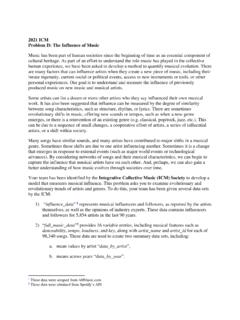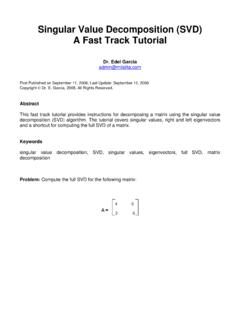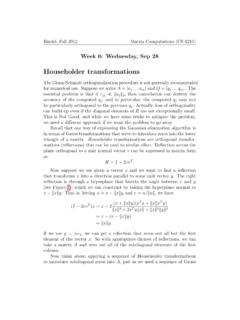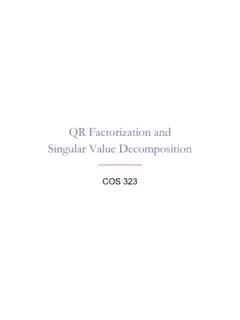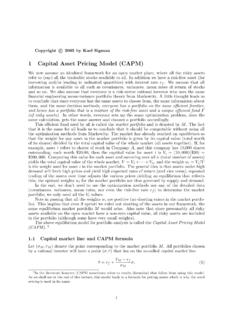Transcription of 2021 MCM Problem A - MATHmodels.org
1 2021 MCM. Problem A: Fungi The carbon cycle describes the process of the exchange of carbon throughout the geochemical cycle of the Earth, and is a vital component for life on the planet. Part of the carbon cycle includes the decomposition of compounds, allowing carbon to be renewed and used in other forms. One key component of this part of the process is the decomposition of plant material and woody fibers. Some of the key agents in decomposing woody fibers are fungi. The authors of a recent research article on wood decomposition by fungi identified fungi traits that determine decomposition rates and also noted links between certain traits[1]. In particular, the slow growing strains of fungi tend to be better able to survive and grow in the presence of environmental changes with respect to moisture and temperature, while the faster growing strains tend to be less robust to the same changes. A synopsis of this article can be found below on page 3.
2 These researchers examined a large number of traits associated with different fungi and their role in the decomposition of ground litter (dead plant material) and woody fibers. For this MCM Problem you should focus on just two traits of a fungus: the growth rate of the fungus and the fungus'. tolerance to moisture. Your primary goal is to model the decomposition of woody fibers in a given patch of land, and do so in the presence of multiple types of fungi breaking down woody fibers in the same area. As you explore the relationship of the two traits of interest, growth rate and moisture tolerance, with the rate of decomposition , several questions may arise to include: Using these two traits, how do the different fungi interact and decompose ground litter in a fixed patch of land in different environments? Within these different environments, how will the decomposition be impacted over time as conditions vary?
3 How do environmental changes and the variation in environmental change impact the long-term dynamics with respect to decomposition , as well as competition between fungi in a given environment? The estimation for the decomposition rates, given the growth rate, is shown in Figure 1. The estimation of the decomposition rates, given the relative moisture tolerance, is shown in Figure 2. Figure 1: The relationship between the hyphal extension Figure 2: The relationship between the moisture tolerance rate (mm/day) of various fungi and the resulting wood (difference of each isolate's competitive ranking and their decomposition rate (% mass loss over 122 days) at moisture niche width, both scaled to [0,1]) of various fungi various temperatures. (Figure 1C in [1]). and the resulting wood decomposition rate (% mass loss over 122 days, log transformed). (Figure 4A in [1]). Requirement: Your paper should explore and address the following aspects.
4 Build a mathematical model that describes the breakdown of ground litter and woody fibers through fungal activity in the presence of multiple species of fungi. In your model, incorporate the interactions between different species of fungi, which have different growth rates and different moisture tolerances as shown in Figures 1 and 2. Provide an analysis of the model and describe the interactions between the different types of fungi. The dynamics of the interactions should be characterized and described including both short- and long-term trends. Your analysis should examine the sensitivity to rapid fluctuations in the environment, and you should determine the overall impact of changing atmospheric trends to assess the impact of variation of local weather patterns. Include predictions about the relative advantages and disadvantages for each species and combinations of species likely to persist, and do so for different environments including arid, semi-arid, temperate, arboreal, and tropical rain forests.
5 Describe how the diversity of fungal communities of a system impacts the overall efficiency of a system with respect to the breakdown of ground litter. Predict the importance and role of biodiversity in the presence of different degrees of variability in the local environment. Include a two-page article of your results. Your article should be appropriate for inclusion in an introductory college level biology textbook to discuss recent developments in our understanding of the roles fungi play in ecological systems. Your PDF solution of no more than 25 total pages should include: One-page Summary Sheet. Table of Contents. Your complete solution. Two-page Article. References list. Note: The MCM Contest now has a 25 page limit. All aspects of your submission count toward the 25 page limit (Summary Sheet, Table of Contents, Reference List and any Appendices). Reference: [1] Nicky Lustenhouwer, Daniel S. Maynard, Mark A.
6 Bradford, Daniel L. Lindner, Brad Oberle, Amy E. Zanne, and Thomas W. Crowther, "A trait-based understanding of wood decomposition by fungi," Proceedings of the National Academy of Sciences of the United States, May 13, 2020. Research Article Synopsis We provide a brief synopsis below of the research article by Lustenhouwer, et al [1]. The original full article is available at Note that you do not need to read the original article to complete this MCM Problem . The decomposition of organic material is a critical component of the carbon cycle. Large scale modeling of the carbon cycle as well as global climate models are becoming more refined and are incorporating more small scale details. One important detail is the rate associated with the decay of organic material by microbial and fungal communities. The focus of the paper is the different decay rates associated with different types of fungi. The authors of the paper explored several different traits of fungi to determine the effects of the decomposition of wood.
7 They did so by measuring how much mass was lost in wood blocks after introducing different types of fungi into the blocks. The researchers examined a large number of different traits associated with each fungus and attempted to determine the role these traits play in the decomposition of the wood blocks. For example, one important trait is the hyphal extension rate. The hyphae are the cells that branch out and form the filaments and structure of a fungus, and the different kind of hyphae play different roles in the life cycle of a fungus. The hyphal extension rate is essentially the growth rate of a fungus. Another trait examined was the density of the hyphae in a given volume. These two traits are associated with a number of properties of a fungus. For example, it was found that if the hyphal extension rate was larger (faster growth), the fungus was more likely to decompose wood faster. Likewise, if the filaments were denser it was more likely that the decomposition of wood was slower.
8 Additionally, these two traits are also associated with how a fungus reacts to different environmental conditions. In particular the researchers found that fungi that were better able to adapt to a more varied range of moisture conditions tended to also decompose wood slower. Fungi that grew faster and out- competed other fungi tended to decompose wood faster. Figures 1 and 2 in the MCM Problem A. statement show these relationships. Woody materials break down through multiple stages, and the fungi that were examined in the research article are most relevant with respect to the decay of woody materials in the middle of their decay cycle. The results may differ for other stages of decay. For the purpose of this modeling exercise, you can focus on the results for the middle stage and assume it is consistent for other stages of decomposition . Another consideration is that local environmental conditions can vary greatly over an area and impact the overall dynamics as well.
9 Glossary: Biodiversity: Broadly, the variety of life in the world. On a smaller scale, the variety of life in a particular habitat or ecosystem. Carbon Cycle: The continuous process (or series of processes) by which carbon is exchanged between organisms and the environment, and then reused throughout the planet. Competitive Ranking: A measure of the ability for a fungus to out-compete other fungi in a series of pair wise tests in similar conditions. Earth's Biosphere: The lithosphere (crust and upper mantle of the earth), the hydrosphere (all of the water on the earth's surface), and the atmosphere (the envelope of gases surrounding the earth). of the earth. Fungus (plural: fungi): Any member of the group of eukaryotic (cells that have a nucleus enclosed within a nuclear envelope) organisms. Examples are yeasts, molds, and mushrooms. Geochemical Cycle: The various pathways and steps by which elements are exchanged through and between the Earth's biosphere.
10 Hyphae: The cells that form the filaments within a fungal community. Hyphal Extension Rate: The rate of growth of a fungus. Moisture Niche Width: The difference between the maximum and minimum moisture levels in which half of a fungal community can maintain its fastest growth rate. Moisture Tolerance: The difference between a fungus' competitive ranking and its moisture niche width.
